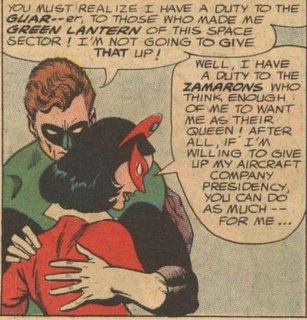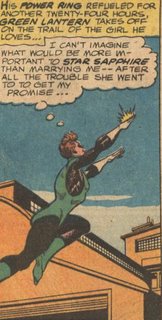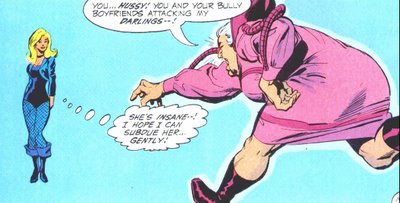There's a conversation going on over at
The Absorbascon about the Justice League, and what power combination a composite super-villain would need to beat them singlehandedly. To me, it's a given that all the villain needs is above average intelligence and the Flash's powers. You see, I've thought a lot about this. I've argued it in the LCS. I've used this to make a good case for why any one of Flash's seemingly incompetent Rogues' Gallery members should be able to wipe the floor with any entire team of heroes sans speedster.
This reminded me of a conversation
Kalinara and I had yesterday that has me musing on the term "fangirl" today. It's a linguistic issue, mainly. In theory, Fanboy and Fangirl are simply gendered terms to differentiate a male fan and a female fan. In practical use, they have not only a different gender but an entirely different meaning.
Internerd Fan-Fiction is believed to be dominated by women. Particularly Slash Gay Fanfic (but really, how could we tell?). It's also widely accepted that Manga is more popular among female readers. There's enough of a stereotype that combines the definition of traditional femininity, the connotation of "girl" and the idiosyncrasies of fandom to get a very clear picture from the word. It conjures an image of blonde pigtails, a Sailor Moon costume, an armful of pink-covered Manga books and a notebook filled with ruminations on the romantic entanglements of dark, moody, brooding male characters. She's excited by the idea of two gay men not because it affords the opportunity to appreciate the male form, but instead because it showcases two males in a loving, caring relationship. Oh, and she can't get enough of The Angst, it has to do with all those afternoon soap operas she watched with Mama.
There's a mood associated with Fangirl, just as there is a mood associated with Fanboy. The mood associated with Fanboys is that of dimly lit comic book stores, with a table set aside for the Saturday Night D&D game, dark blue/black T-shirts with superhero logos/smartass phrases ("C:/DOS C:/DOS/RUN RUN/DOS/RUN"), an argument about whether the Hulk or Superman would win in a fight, wacky crossover ideas, lifesize cardboard cutouts of Lara Croft, and round the clock internet access. Gay or Straight, he wants to cut the Angst and get on with the Action, he feels the best reason for cheesecake and sexually explicit scenes is the titillating view it offers, and he just giggled at the first syllable in the word "titillating."
Fanboy is a "Blue" term, as in "Blue is for Boys." Whereas, Fangirl is a "Pink" term, as in "Pink is for Girls." There is nothing inherently wrong with blue or pink. Both are fine colors, moods, acceptable lifestyles. But these colors represent traditional gender roles. The pink term of Fangirl embraces traditionally feminine traits like emotional/romantic thinking, pastel colors, cutesy things, and an audible high-pitched squeal associated with hearing about an opportunity to meet David Cassidy. The blue term of Fanboy embraces traditionally masculine traits like logical/statistical thinking, primary colors, blood and gore, and manly grunting/deep voiced "oh yeah"s.
I'm becoming increasingly uncomfortable with the term "Fangirl" -- mainly because I'm not fitting the stereotyped role very well. I'm not a big fan of angst. Not the long drawn out kind. One story of angst, okay, but on the whole I prefer to cut it short and get with the action. I've never been able to get into Manga. As fun as it is to make jokes about homoerotic content in the actual comic, I'd prefer not to read or write an entire fanfic about the encounter. I cheered on Obsidian's coming out partially because it offered a chance to see him in bed with a particularly handsome backup character, but mostly because it put an end to the Constant Angst that was Todd Rice's Personality. A lot of crap can be blamed on repression in this case.
Basically, I, and most of the fans I associate with (of either gender) are a mixture of both types, but leaning towards the "Fanboy."
And none of this occurred to me until yesterday, when we crossed the line. As usual, we were discussing Green Lantern. I'm not sure why the idea came about, but it did, and I asked Kalinara would would win if Guy Gardner (as Warrior, who was basically a shapeshifting Superman with energy blasts) fought Kyle Rayner (as Ion -- not the omnipotent version, but the upcoming somewhat-more-powerful-than-a-Lantern version). I said Kyle and she said Guy. We then proceeded to lay out the circumstances of battle, and hammer out a chart which stated who would win under what conditions, after discussing the planning and combat abilities of each characters.
During the entire conversation, we never once discussed whether they would kiss, or feel bad about the battle afterwards, or even if their clothes would be torn off. Once we'd ironed out the winner in each circumstance, Kalinara remarked that we'd given up female status on this one. I laughed then.
Unfortunately, it's not so funny when you think about it.














